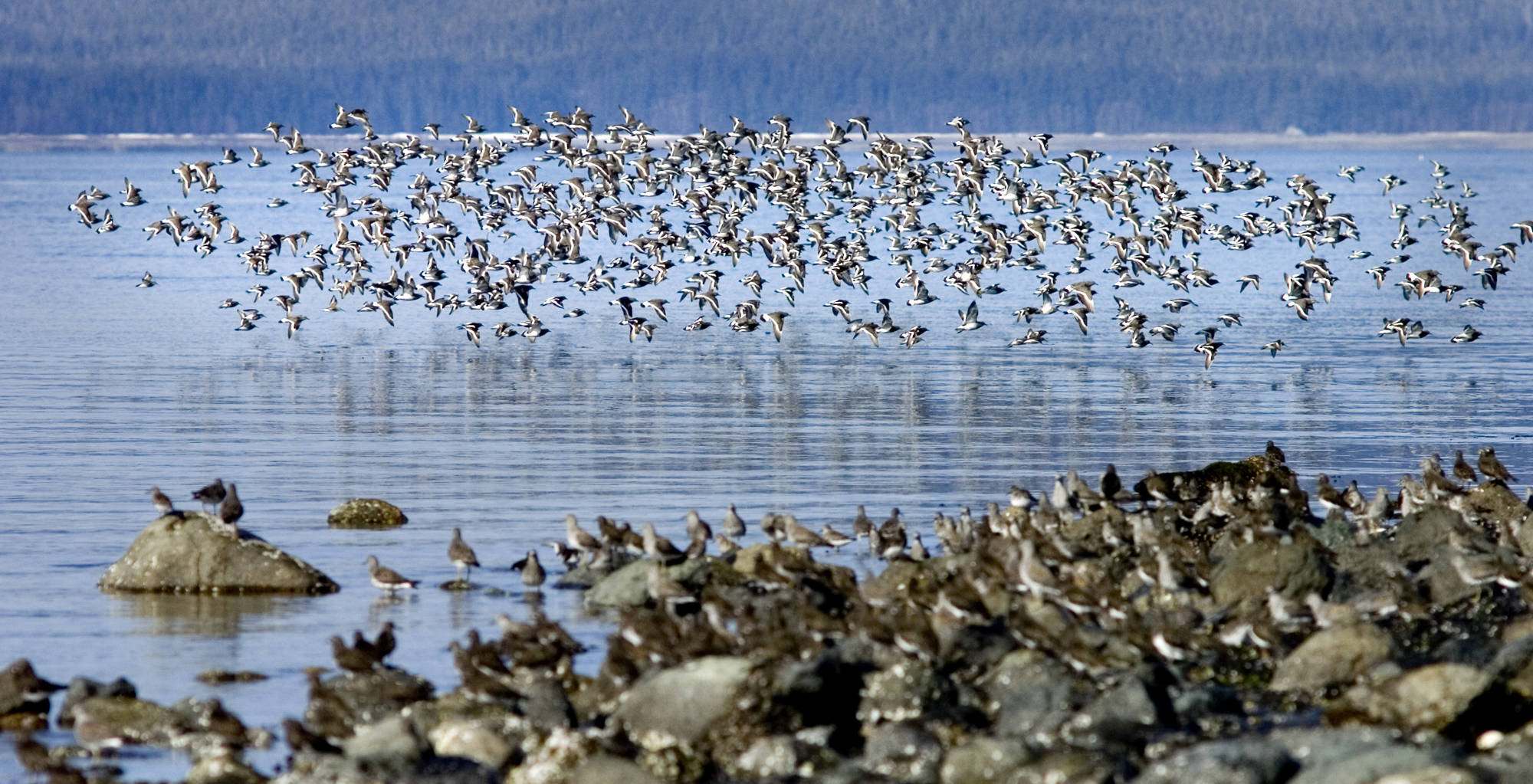It is said that “birds of a feather flock together,” and indeed they do.
We see gangs of crows — sometimes 100 or more — foraging together on the wetlands or at the tideline. A skein of Canada geese flies overhead, talking all the time. Better yet, a little troop of trumpeter swans flies up the channel, their whiteness contrasting well against the dark mountainsides.
Why do such birds do things in groups? There are (so far) three main kinds of reasons.
When geese or swans fly together on extended flights, they usually do it “in formation” — about a meter apart in a line or a V, they gain aerodynamic advantages. A vortex forms at each wing tip, creating down-drafts and up-drafts. By flying at the appropriate distance from another goose and timing its wing-flaps to catch the up-drafts, a goose that follows another one gains lift and saves energy.
When crows, buntings or shorebirds forage in bunches, one possible benefit lies in protection from both aerial predators, such as eagles, hawks or owls and ground-based predators, such as coyotes or dogs. A bird foraging alone must keep a sharp lookout for possible predators, and the time spent being vigilant decreases the time available for feeding. In a group, however, there can be many eyes watching and everyone can spend more time eating. In a flock of geese, grazing with their heads down, there is almost always at least one with its head up, being vigilant; a few minutes later, a different bird will be the sentinel. Furthermore, if a group of birds is startled into flight by an approaching predator, the whirl of many frightened birds might distract the predator, making it harder for the attacker to focus on a particular bird.
There may also be advantages in locating and exploiting a food resource. In some cases, particularly in species that are quite sociable year-round, if one bird finds a nice patch of food, that bird might signal to its friends and relations to come join the feast, and the rest of the gang just follows. I suspect crows might do this.
Sometimes, the foraging activities of one bird might make food more available to its opportunistic companions. A bird fossicking about in the wrack line, for example, might stir up any number of invertebrates, making them vulnerable to the next comer. Then every bird in a foraging group may take advantage of that and, in so doing, stir up more prey. Another example: dense squadrons of scoters cluster on the surface of a bay or channel often make what I call “chain dives”— one bird at the edge of the flock dives deep and all the others, in a line, follow the lead, moving up to dive in the same spot as the first diver. I have to wonder if the foraging activity of the first birds might loosen up a congregation of mussels, for instance, and make it easier for the later divers in the chain to pluck them up.
There are also times (and places) when birds that are not of the same feather flock together. These mixed-species flocks occur most commonly in forests around the world. In North America, mixed-species flocks form in winter, and commonly include chickadees, which are often the focal or “nuclear” species, accompanied by golden-crowned kinglets, and maybe nuthatches or brown creepers or even a downy woodpecker. The various species in such a flock are not related to each other nor do they forage in the same ways, although they typically all eat insects and spiders found in the forest canopy. In our local forests, I have found mixed flocks of chickadees and golden-crowned kinglets in winter, but I seldom detect the other likely follower-species (of course, I simply might miss them!).
Obviously, the “many eyes” idea applies to multi-species flocks. In many cases the birds in the flock are foraging at some distance from each other, maybe even out of visual contact, but the cohesion of the flock is maintained by vocalizations. Each bird may be foraging independently, but if one bird spots a predator, the whole flock may be notified to be on watch. By joining such a flock, and depending on the watchfulness of everyone, each bird might gain more time for feeding; this had been shown to occur in some situations. In a few cases, the foraging of one species might create feeding opportunities for others: for example, the tapping and bark-scaling of a downy woodpecker could make hidden bugs accessible to birds that glean surfaces.
As usual, many questions remain. Why do chickadees usually serve as nuclear species, drawing other birds together in a foraging flock? Do nuclear species benefit as much as their followers do? What triggers the formation of a mixed flock at certain times or places? How long do these flocks stay together, and what leads to the eventual breakup of the flocks? Under what circumstances might the foraging activity of one species benefit another? A curious naturalist might not have a ready answer to such questions, but formulating questions is usually the first step in finding answers. Sometimes finding an answer is not even the most useful outcome of questioning; the very act of questioning can stimulate new insights and perspectives.
• Mary F. Willson is a retired professor of ecology. “On The Trails” appears every Friday. Her essays can be found online at onthetrailsjuneau.wordpress.com.

